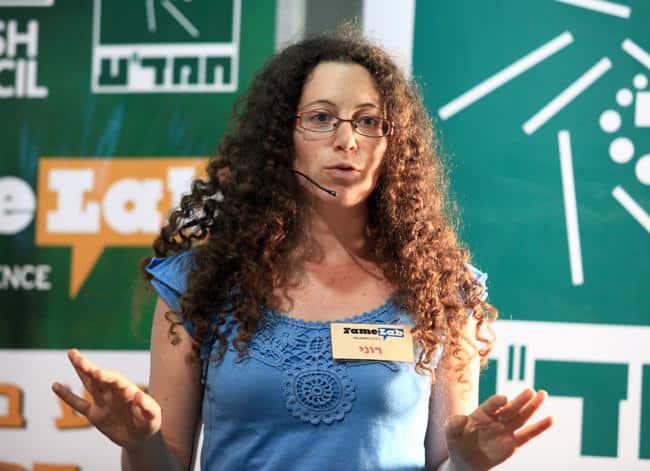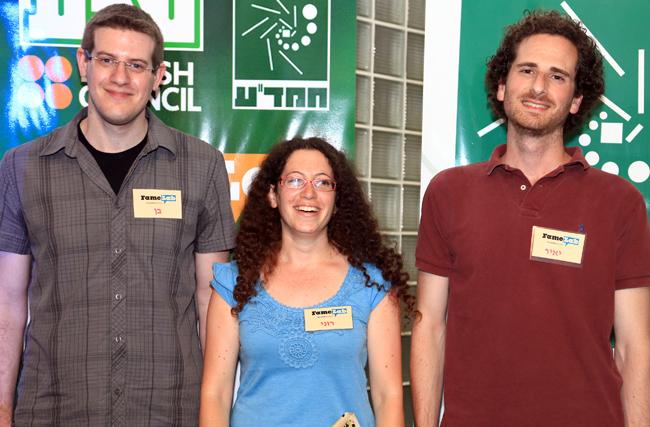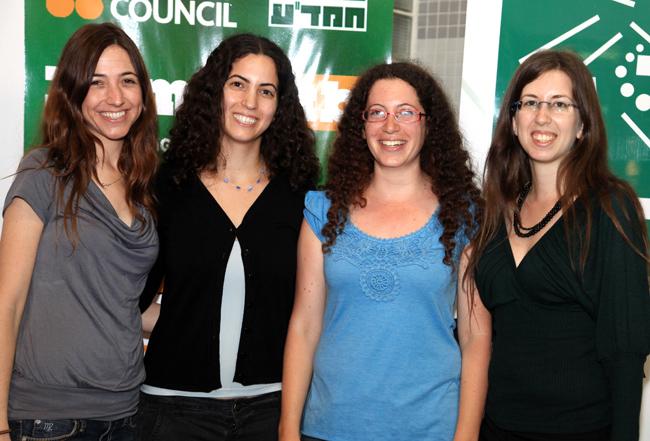described through the story of the Red Queen Alice in Wonderland the evolutionary arms race between predators and prey. Second place went to Yair Ben Horin from the Hebrew University and third to Ben Horowitz from the Technion

Atida is the fourth winner of the competition after Michal Dekal, Adi Yaniv and Shani Wiedergorn, who won the competition in previous years. As a prize for her win, Atidai was awarded a laptop gift from Teva, and she will also fly to the science festival in Chatham in the UK and represent Israel at a meeting of FeyLab winners and winners from many European countries.
In her lecture, Atidia described the Red Queen, who is in the Land of Mirrors, where one of the plots takes place, and both of them run until they are no longer able to, and when Alisa stopped she saw that in fact they had not progressed at all "here you have to run to stay in place" the Red Queen told her.
Lewis Carroll who wrote the story did not think that more than a century later it would be used as an analogy for the rapid technological changes that humanity is experiencing at the beginning of the 21st century, nor did he know that it actually describes the evolutionary arms race between different animals.
For example, the deer and the cheetah, when the running ability of both increased - the deer to run and the cheetah to hunt, up to a certain limit where it was impossible to continue increasing the speed. Another evolutionary race is between the cuckoo and the host birds, where the cuckoo tries to lay eggs as similar as possible to the host bird's eggs, and the host bird tries to identify the eggs and get rid of them before they hatch. But the race stops after the egg hatches and the cuckoo chick comes out and throws the other eggs out of the nest. The host bird raises it anyway, perhaps because nature has not been kind to the birds who mistakenly identified the cuckoo chick as their offspring and destroyed their true offspring.
In a conversation with the science website after her win, Atidia referred to the combination of a bachelor's degree in biology and language: "I was looking for some kind of combination of several fields that I like." As for the popularization of science, she explains: "I tutored for many years at the Science Museum in Jerusalem and that's where I was first exposed to the competition. I liked it when I was sitting in the audience last year and this year my friend from the museum took the trouble to remind me that the competition was taking place and invited me to register, I thought it would be an interesting experience and a nice experience."
What is the importance you see in scientific communication?

"The way to understand many things in the world, including ourselves, is to understand ourselves scientifically, with the help of different fields of science, a combination of different fields in science, and sometimes it may seem like a complex and complicated and distant thing to some people, but in fact everyone can find the fields that interest them more And that he is able to understand them and delve into them."
Second place went to Yair Ben Horin, a graduate of physics and philosophy at the Hebrew University and he is still an instructor at the Science Museum. Ben Hurin demonstrated a treatment developed by two Israeli researchers to introduce weak magnetic currents into the brain which unite at one point and treat it without the need to insert electrodes into the brain and treat depression.
"I just finished my bachelor's degree but I think that what I will study in the future will deal not only with physics but with a combined field - physics and medicine or physics and neuroscience for example."
How important is scientific communication to you?
"I've been working at the science museum for two years, I really like my job, people come to us, explain things to them that we may not know or know less and show them in more fun and communicative ways. It's a challenge, but in the end we succeed in it."
Ben Horowitz, a master's degree student in the Department of Microbiology at the Faculty of Medicine at the Technion, won third place and the title of crowd favorite. Horowitz is engaged in the study of the induced death of cancer cells by a viral protein. Horowitz described the cell's suicide mechanism, when it senses, for example, chemical substances in chemotherapy, radiation or the teaching of the immune system, and estimated that if we get to know this mechanism better, we can instruct cancer cells to kill themselves.
Also participated:

Karin Ardon Dreyer, a doctoral student at Tel Aviv University in the Department of Geophysics and Planetary Sciences who studies the effect of air pollution on the development of ice in clouds and the formation of precipitation, spoke about the effect of volcanoes on the cooling of the Earth and estimated that the eruption of the volcano in Iceland will not have the same effect as the eruption of Pinatubo in the Philippines in 1991, due to Its strength is much weaker.
Guy Rosenzweig, a doctoral student in plasma physics at the Weizmann Institute of Science and an instructor at the Weizmann Institute's Science Garden, spoke about spectroscopy - or light as a thermometer; Ofir Reich, a master's student in mathematics at the Hebrew University of Jerusalem and a soldier in regular service spoke about the birthday effect; Oded Shapir, a doctoral student in the tissue and stem cell engineering laboratory at the Technion where he is trying to develop new approaches to reconstructing pancreatic tissue for the treatment of juvenile diabetes patients, but he chose to talk about gene therapy for Williams syndrome patients; Hana Artzi, a doctoral student in the Department of Endocrinology at Hadassah, lives in the settlement of Ahia in the Binyamin region, who explained through an experiment to measure the effect of prayer on medical parameters the question of how a scientific experiment should be planned in order for it to be valid and why in this experiment the rules were not followed.
The judges of the competition were Dodi Goldman, the science reporter of Yedioth Ahronoth, Adi Matan of the attaché for science and technology affairs at the British Embassy, Dr. Liat Hirdani from Teva and Prof. Elam Gross from the Weizmann Institute.
Eitan Krain Mahmad'a, the moderator of the competition, said that this year Hamad'a took over the organization of the competition, after the British Council had done so in the previous three years. The winner will meet, in addition to winners from the nine old countries, where the organization passed into local hands, also winners from other places: Portugal, Germany, Morocco, Egypt and Libya - where a winner has already been announced.
Crane gave several examples of the need for scientific communication, a prominent example is the attitude of the public to the issue of global warming which, according to the media, is controversial, while among scientists the absolute majority is convinced that it exists and is man-made, and the second issue - the removal of Pluto from the status of a planet which received many echoes in the USA .
Carol Sting - the vice-chairman of the British Council said that science was refined when it was necessary to explain to people why it is impossible to fly to Europe.

8 תגובות
So that the organizers of the competition think of a better way to give people an assessment so that they take into account both the level/difficulty of the topic that they manage to convey to people who are not related to the field and also the way they do it and of course refer to the connection between the lecture and the people's research....
I was in a competition and left disappointed....
The final lectures will be uploaded to YouTube next week. You can see the lectures of the last few years on the FameLabIsrael channel
I noticed and tried to correct, nevertheless the news came up almost in real time.
What about spelling mistakes?
It's a shame that a site that claims to be professional and a leader in its field like 'Hidan' does not make sure that its writers proofread the texts they put on the site. And it's certainly not the first time.
For the attention of the system.
Red Queen!
It was a great lecture in three minutes.
Beyond the beautiful scientific idea, it was possible to learn yesterday how to simplify a complicated idea, how to plan an engaging lecture, how to integrate other areas of content and culture and above all how to stand in front of a large crowd of people from different backgrounds.
Worth watching
The lectures will be uploaded to YOUTUBE in the coming days 🙂
Oops… actually there are a few videos
It's a shame that these lectures are not on YouTube
I am sure there are many children and youth who would be happy to hear these amazing contents